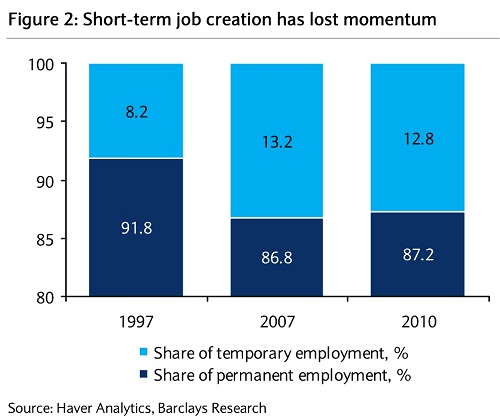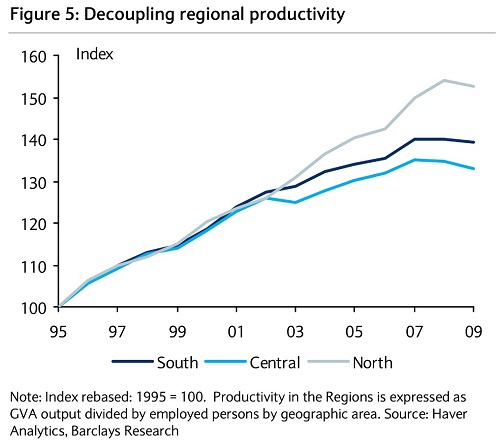LONDON | Italian prime minister may have to introduce in his country the labour market reform á la Spanish he much praised not long ago. Among the statistics that are increasingly flagging a red light in the Italian economy, unemployment is gaining some attention. Although Italy’s labour market underwent substantial adjustments over the past two decades, with the 1997 Treu measures and the 2003 Biagi reform, the employment growth and labour market flexibility of those days seem to be now in the past.

Compared to its peers, the adjustment was significant. Between 1998 and 2007, the Italian unemployment rate fell more than 5 percentage points to 6.1%, reaching its all-time lows against more modest declines recorded in Germany, France and in the euro area as a whole (0.7pp, 2.4pp and 2.7pp respectively).
Of the large euro economies, the only one which experienced a sharper decline in the unemployment rate was set on a huge construction bubble, that is Spain, where labour market dynamics were distorted by a real estate boom. But, as Barclays Capital analysts point out,
“at the end of 2007, the Italian unemployment rate reversed trend, increasing to 10.2% in April this year. The pace of the increase warrants close scrutiny, in our view.”
Ideed, the Italian labour market has lost in less than three years about half the gains it achieved in the previous decade.
“We believe additional intervention is needed to prevent further deterioration in the Italian labour market,” Barclays says.
“Focused on promoting the use of temporary contracts, the current regulatory framework created a two-tier labour market, with some workers overly protected with open-ended contracts and others in fixed-term contracts lacking job security. Segmentation in the labour market lowers the incentives to invest in human capital and exposes those in temporary contracts to lay-offs during downturns.
“Ultimately, a two-tier labour market leads to high structural unemployment and impairs potential GDP growth.”
Between 1997 and 2007, total employment gains were in mainly short-term jobs. The share of temporary employment increased from 8.2% to 13.2%, while it remained broadly unchanged thereafter, suggesting that the main source of job creation in the past 20 years lost momentum. On the other hand, permanent employment declined from 91.8% to 86.8% between 1997 and 2007 and remained broadly unchanged afterwards.

There is an internal peripheral/core partition, too, Italy should attend to before it becomes one more obstacle for the Mediterranean economy to recover. According to Barclays experts, the need for a better wage response to different regional conditions has become more relevant in the past 10 years. After trending close to each other for years, labour productivity among regions have been decoupling since 2002.
“While productivity remained broadly aligned to its long-term trend in Northern Italy, it showed a sharp deterioration in Southern and Central Italy.”





